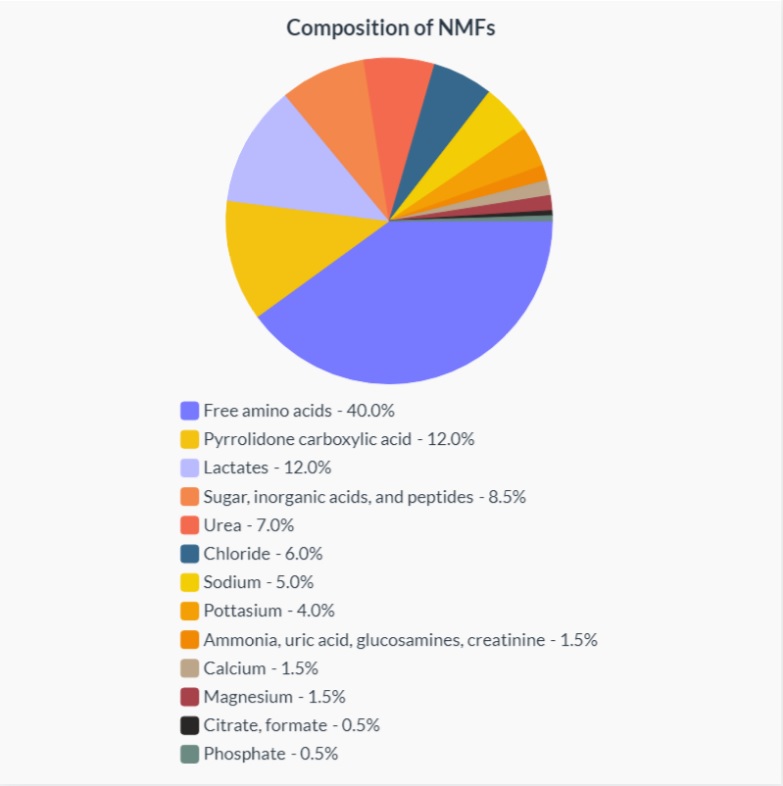Did you know that the skin has an incredible ability to retain water and maintain proper cell hydration? Enter: natural moisturizing factors (NMFs). This mechanism is essential for the skin and has a massive role in how hydrated, resilient, and healthy it is. Sadly with age and due to other factors, the skin can suffer a loss of NMFs, so identifying these culprits (and eliminating them) should be top of mind. The good news is that you can boost the natural moisturizing factors and help prevent their early degradation with just a few additions to your beauty routine. From what role they have to how to maintain their levels in place, below is the full 411 on natural moisturizing factors in skincare.
What is natural moisturizing factor?
The NMF is a mixture of small water-soluble compounds found in the stratum corneum (the uppermost layer) that the skin uses to keep itself hydrated and protected. The main components found in natural moisturizing factors include a mix of amino acids and other hygroscopic elements (aka, absorb moisture from the air), such as lactates, sugar, and urea. Generally, they act as humectants to attract water molecules into the skin and seal it.[1]

The roles of NMFs
The primary role of natural moisturizing factors is to regulate moisture content by drawing water molecules from the environment and attaching them to the skin. Additionally, NMFs play a defensive role, meaning they make up a protective barrier so bacteria and other microorganisms can’t penetrate the skin. Coupled with naturally occurring lipids, like ceramides and cholesterol, the natural moisturizing factors keep the outer skin layer firm, elastic and supple.
What affects the skin’s NMF
Age and excessive sun exposure are the major culprits that lead to a decline in natural moisturizing factors. While you can’t do much about the former, you can help prevent the latter by limiting your time in the sun and using diligent sun protection. Prolonged water immersion can also cause a drop in the NMF, so you want to think twice before you take long and hot baths.[2] Other factors that affect the skin’s NMF are surfactants, such as sodium lauryl sulfate, usually found in cleansers, and some skin conditions, like dermatitis, xerosis, and eczema.[3]
These are the factors that can cause a decline in NMF:
- Aging
- UV exposure
- Certain skin conditions
- Pollution
- Overbathing
- Low humidity levels
- Surfactants
- Poor diet
- Stress
How to improve the skin’s NMF
With quite a few causes that decrease the NMFs in the skin, no wonder we’re always on the hunt to give them a helping hand to maintain skin hydrated and resilient. Here is what you can do to improve the natural moisturizing factors and increase your skin’s ability to hold on to moisture:
Stay hydrated
Drinking water is top of the list to keep the skin hydrated. Health experts recommend drinking about 2 liters of water daily, which equals eight glasses. However, you can also take fluids from other sources, like soups, vegetables, fruit, and smoothies.
Watch your diet
Because the skin is hydrophilic (mixes with water) and lipophilic (is attracted to lipids), it needs both water and lipids to stay hydrated. So, in order to maintain proper NMF levels, you need to consume healthy fats in your daily diet. Foods like avocado, nuts, seeds, almonds, mackerel, and salmon are examples that have a positive effect on the overall hydration of skin levels. Oral collagen, ceramide, and omega supplements are also essential in maintaining skin hydration, as well as vitamin C-rich foods.[4]
Apply sunscreen daily
Sunscreen is non-negotiable every day. Since UV exposure is one of the biggest culprits that decrease natural moisturizing factors, keeping the complexion defended against the harmful sun’s rays is essential, regardless of the season or temperature. Apply a broad-spectrum sunscreen (protects against UVA and UVB rays) with at least 30 SPF every morning, and reapply it every two hours when you spend time outdoors to help prevent the disruption of NMF.
Use a non-stripping cleanser
What you do (and do not do) in your skincare routine affects the natural moisturizing factor. For instance, the basic step of any skincare routine, the cleanser, can have a substantial negative impact on the complexion and leave it parched. Abrasive particles, sulfates, salicylic acid, drying alcohol, and synthetic fragrances are all guilty of leaving the hydration impaired, so you want to ensure your cleanser skips all of the above. Instead, pick a gentle gel or creamy cleanser that washes away impurities without stripping, wash your face with lukewarm water, as hot water can deplete moisture, and pat it dry without rubbing.
Watch out how often you exfoliate
Over-exfoliation can also cause a loss of NMF, so you want to stick to a maximum twice weekly exfoliation. There are different types of exfoliants, and you should choose one according to your skin type and level of tolerance. We strongly suggest incorporating polyhydroxy acids (PHA) into your routine to avoid stripping the skin — they work similarly to alpha-hydroxy acids, just gentler due to their higher molecular weight. Hence, they’re less likely to bother the NMF.
Apply humectants
Quite a few compounds act like the skin’s natural moisturizing factors, including hyaluronic acid, glycerin, panthenol, and aloe vera. All these belong to a class named humectants and work by attracting water molecules into the skin, increasing hydration, and maintaining the complexion moist. Therefore, applying products, preferably serums or moisturizers, that contain humectants can help improve the skin’s NMF.
Use occlusives
Lastly, incorporating a moisturizer with occlusives into your routine is key to locking water in and preserving the NMF. Occlusives like petrolatum, fatty acids, ceramides, and cholesterol, shea butter, are best at sealing moisture into the skin and blocking water loss by coating the surface with a protective film. Without them, humectants may actually dehydrate the skin, so you have to make sure your moisturizer contains occlusives too.
The takeaway
Natural moisturizing factors are pivotal substances in the outer skin layer that help keep it hydrated and healthy. Because a lot of factors (like UV damage and harsh cleansers) can deplete NMFs and lead to parched skin, you should put in place a strategy to keep their levels in place. These include wearing sunscreen daily, using humectants, replenishing moisturizers, having a diet rich in healthy fats, and hydrating sufficiently.
Footnotes
Women’s Concepts uses reliable sources, including dermatologists’ insights, clinical trials, and scientific journals, to find accurate information and support all the facts shared in our articles. All statements and claims have clear and legit references. Read our editorial policy to learn more about our sources of information, our process of researching and fact-checking the content, and how our team strives to keep all articles updated, completed, and trustworthy.
- Journal of the American Academy of Dermatology, Basic Science, Volume 60, Issue 3, Supplement 1, AB37, March 01, 2009, Mechanisms of natural moisturizing factors for skin hydration
- Visscher, Marty & Tolia, Gaurav & Wickett, R. & Hoath, Steven. (2003). Effect of soaking and natural moisturizing factor on stratum corneum water-handling properties. Journal of cosmetic science. 54. 289-300.
- Maria Gunnarsson, Enamul Haque Mojumdar, Daniel Topgaard, Emma Sparr, Extraction of natural moisturizing factor from the stratum corneum and its implication on skin molecular mobility, Journal of Colloid and Interface Science, Volume 604, 2021, Pages 480-491, ISSN 0021-9797
- Qian Sun1, Jingping Wu1, Guofei Qian2, and Hongbin Cheng3, Department of Medical Cosmetology, Hospital of Chengdu University of Traditional Chinese Medicine, Chengdu, China, Effectiveness of Dietary Supplement for Skin Moisturizing in Healthy Adults: A Systematic Review and Meta-Analysis of Randomized Controlled Trials




![Does resveratrol in red wine benefit your skin? While sipping on a glass of red wine can be a delightful experience, relying on it for skincare benefits is not the best idea. Sure, red wine contains a smidge of resveratrol, but let's put things into perspective. The concentration of resveratrol in red wine is relatively low. Red wines, specifically Pinot noir from France, typically contain 0.361-1.972 mg of resveratrol per liter.[8] To hit that reference dose of 500mg of resveratrol, you'd need to drink a lot of wine. We're talking about downing anywhere from 100 to 1000 glasses per day. It's a scene straight out of a wine lover's wildest dreams, but definitely not the healthiest approach. Resveratrol Benefits for Skin](https://womensconcepts.com/wp-content/uploads/2022/03/Resveratrol-Benefits-for-Skin.jpg)
